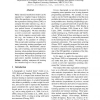Free Online Productivity Tools
i2Speak
i2Symbol
i2OCR
iTex2Img
iWeb2Print
iWeb2Shot
i2Type
iPdf2Split
iPdf2Merge
i2Bopomofo
i2Arabic
i2Style
i2Image
i2PDF
iLatex2Rtf
Sci2ools
EMNLP
2009
2009
First- and Second-Order Expectation Semirings with Applications to Minimum-Risk Training on Translation Forests
Many statistical translation models can be regarded as weighted logical deduction. Under this paradigm, we use weights from the expectation semiring (Eisner, 2002), to compute first-order statistics (e.g., the expected hypothesis length or feature counts) over packed forests of translations (lattices or hypergraphs). We then introduce a novel second-order expectation semiring, which computes second-order statistics (e.g., the variance of the hypothesis length or the gradient of entropy). This second-order semiring is essential for many interesting training paradigms such as minimum risk, deterministic annealing, active learning, and semi-supervised learning, where gradient descent optimization requires computing the gradient of entropy or risk. We use these semirings in an open-source machine translation toolkit, Joshua, enabling minimum-risk training
EMNLP 2009 | Gradient | Hypothesis Length | Many Statistical Translation | Natural Language Processing |
| Added | 17 Feb 2011 |
| Updated | 17 Feb 2011 |
| Type | Journal |
| Year | 2009 |
| Where | EMNLP |
| Authors | Zhifei Li, Jason Eisner |
Comments (0)

